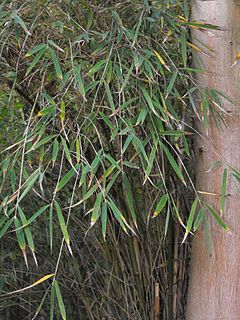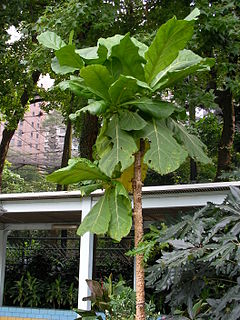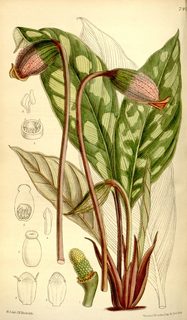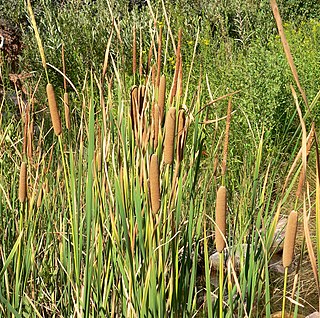
Boesenbergia rotunda, Thai กระชาย krachai, commonly known as Chinese keys, fingerroot, lesser galangal or Chinese ginger, is a medicinal and culinary herb from China and Southeast Asia. In English, the root has traditionally been called fingerroot, because the shape of the rhizome resembles that of fingers growing out of a center piece.
Holttumochloa is a genus of Malaysian bamboos in the grass family native to the hill forests of Peninsular Malaysia. It is sometimes included in the genus Bambusa.

Cephalostachyum is a genus of Asian and Madagascan bamboo in the grass family.
Temburongia is a genus of bamboo from the Sultanate of Brunei on the Island of Borneo. It is usually classified in the subtribe Shibataeinae, though its exact relationship with the subtribe remains unclear.

Musa is one of two or three genera in the family Musaceae. The genus includes flowering plants producing edible bananas and plantains. Around 70 species of Musa are known, with a broad variety of uses.

Fagraea is a genus of plants in the family Gentianaceae. It includes trees, shrubs, lianas, and epiphytes. They can be found in forests, swamps, and other habitat in Asia, Australia, and the Pacific Islands, with the center of diversity in Malesia.
Scaevola muluensis is a species of plant in the family Goodeniaceae. It is endemic to Borneo where it is confined to Sarawak. This plant was first described in 1993 by the botanist Khoon Meng Wong in the journal Sandakania.

Homalomena is a genus of flowering plants within the family Araceae. Homalomena are primarily found in southern Asia and the southwestern Pacific, but there are a few species that are known to be indigenous to Latin America. Many Homalomena have a strong smell of anise. The name derives apparently from a mistranslated Malayan vernacular name, translated as homalos, meaning flat, and mene = moon.

Aridarum is a genus of flowering plants in the family Araceae. All of the known species in this genus are rheophytic and are endemic to the Island of Borneo. The plant is aquatic and has willow-shaped leaves that are able to take strong currents without sustaining damage.

Piptospatha is a genus of flowering plants in the family Araceae. The genus is characteristic is rheophytic and has seeds that are dispersed by splashes of water hitting its cup-like spathes. It is native to Southeast Asia.
- Piptospatha burbidgei(N.E.Br.) M.Hotta - Sarawak, Sabah
- Piptospatha elongata(Engl.) N.E.Br. - Kalimantan Barat
- Piptospatha impolitaS.Y.Wong, P.C.Boyce & Bogner - Sarawak
- Piptospatha insignisN.E.Br. - Sarawak
- Piptospatha manduensisBogner & A.Hay - Kalimantan Timur
- Piptospatha marginata(Engl.) N.E.Br. - Sarawak
- Piptospatha perakensis(Engl.) Ridl. - southern Thailand, Peninsular Malaysia
- Piptospatha remiformisRidl. - Sarawak
- Piptospatha repensH.Okada & Tsukaya - Kalimantan Barat
- Piptospatha ridleyiN.E.Br. ex Hook.f. - Johor, Pahang, Selangor
- Piptospatha truncata(M.Hotta) Bogner & A.Hay - Sarawak
- Piptospatha viridistigmaS.Y.Wong, P.C.Boyce & Bogner - Sarawak

Typha domingensis, known commonly as southern cattail or cumbungi, is a perennial herbaceous plant of the genus Typha.

Irvingia malayana, also known as wild almond or barking deer’s mango, is a tropical evergreen tree species in the family Irvingiaceae. The specific epithet malayana is from the Latin meaning "of Malaya".
Bungarimba is a genus of flowering plants in the family Rubiaceae. The type species was transferred from Porterandia by K.M. Wong in 2004. The genus is found from Borneo, Malaysia, Sumatra and New Guinea.
Musa borneensis is a species of wild banana, native to the island of Borneo, in the Malaysian states of Sabah and Sarawak. It is placed in section Callimusa, having a diploid chromosome number of 2n = 20.
Kochummenia is a genus of plants in the family Rubiaceae. It contains two species, both endemic to Peninsular Malaysia.
Canarium pilosum is a tree in the family Burseraceae. The specific epithet pilosum is from the Latin meaning "hairy", referring to the soft hairs of the twigs and leaves.
Apoballis is a genus of plants in the Araceae. It is native to Southeast Asia, primarily the Island of Sumatra in Indonesia. Some authorities regard this group as part of the larger genus Schismatoglottis.
- Apoballis acuminatissima(Schott) S.Y.Wong & P.C.Boyce - Sumatra
- Apoballis belophylla(Alderw.) S.Y.Wong & P.C.Boyce - Sumatra
- Apoballis brevipes(Hook.f.) S.Y.Wong & P.C.Boyce - Sumatra, Thailand, Peninsular Malaysia
- Apoballis grandiflora(Alderw.) S.Y.Wong & P.C.Boyce - Sumatra
- Apoballis hastifolia(Hallier f. ex Engl.) S.Y.Wong & P.C.Boyce - Sumatra
- Apoballis javanica(Engl.) S.Y.Wong & P.C.Boyce - Java
- Apoballis longicaulis(Ridl.) S.Y.Wong & P.C.Boyce - Sumatra
- Apoballis mutata(Scort. ex Hook.f.) S.Y.Wong & P.C.Boyce - Myanmar, Sumatra, Thailand, Peninsular Malaysia
- Apoballis okadae(M.Hotta) S.Y.Wong & P.C.Boyce - Sumatra
- Apoballis ovata(Schott) S.Y.Wong & P.C.Boyce - Sumatra
- Apoballis rupestris(Zoll. & Moritzi) S.Y.Wong & P.C.Boyce - Sumatra, Java, Bali, Lombok, Timor
- Apoballis sagittifolia(Alderw.) S.Y.Wong & P.C.Boyce - Sumatra

Semecarpus cuneiformis is a tree in the cashew and sumac family Anacardiaceae. The specific epithet cuneiformis is from the Latin meaning "wedge-shaped", referring to the leaf base.
Utania is a genus of flowering plants belonging to the gentian family (Gentianaceae), the tribe Potalieae, and the subtribe Potaliinae. A small genus it has 12 species.
Utania racemosa is a species of flowering plant in the family Gentianaceae. It occurs in Southeast Asia from Sumatera in Indonesia to the Andaman Islands in India. Its wood is used for timber and fuel.









